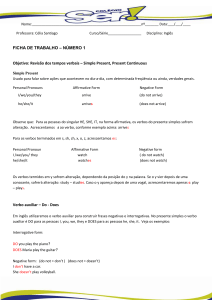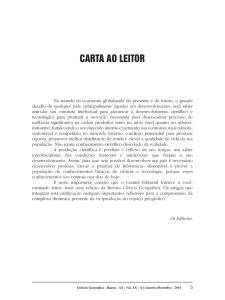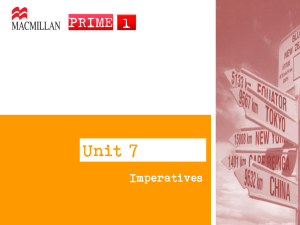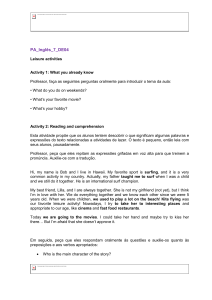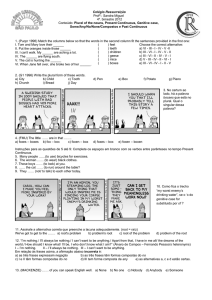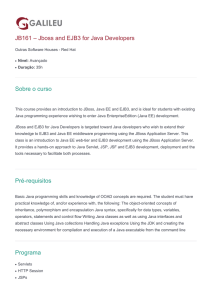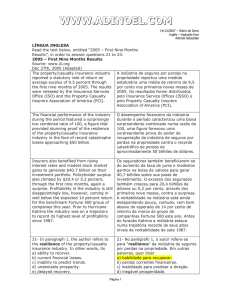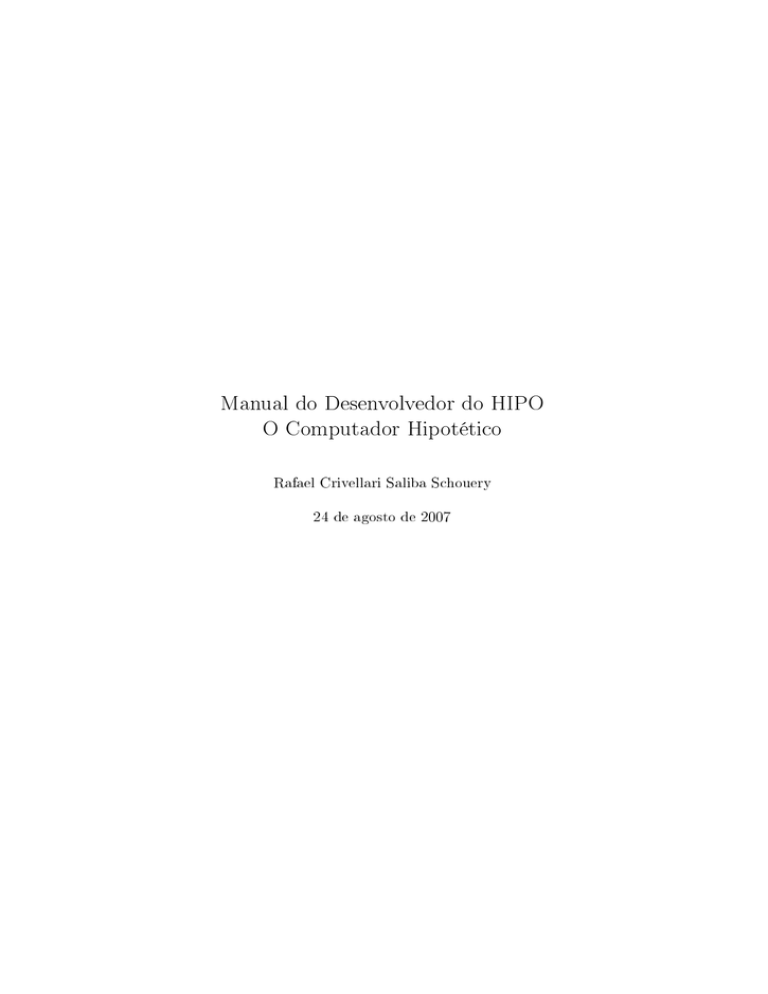
Manual do Desenvolvedor do HIPO
O Computador Hipotético
Rafael Crivellari Saliba Schouery
24 de agosto de 2007
1
Copyright (c) 2007 Rafael Crivellari Saliba Schouery. Permission is granted
to copy, distribute and/or modify this document under the terms of the GNU
Free Documentation License, Version 1.2 or any later version published by the
Free Software Foundation; with no Invariant Sections, no Front-Cover Texts,
and no Back-Cover Texts. A copy of the license is included in the section
entitled "GNU Free Documentation License".
Sumário
1 GNU Free Documentation License
1. APPLICABILITY AND DEFINITIONS . . . . . . . . .
2. VERBATIM COPYING . . . . . . . . . . . . . . . . . .
3. COPYING IN QUANTITY . . . . . . . . . . . . . . . .
4. MODIFICATIONS . . . . . . . . . . . . . . . . . . . . .
5. COMBINING DOCUMENTS . . . . . . . . . . . . . . .
6. COLLECTIONS OF DOCUMENTS . . . . . . . . . . .
7. AGGREGATION WITH INDEPENDENT WORKS . .
8. TRANSLATION . . . . . . . . . . . . . . . . . . . . . .
9. TERMINATION . . . . . . . . . . . . . . . . . . . . . .
10. FUTURE REVISIONS OF THIS LICENSE . . . . . .
ADDENDUM: How to use this License for your documents
.
.
.
.
.
.
.
.
.
.
.
.
.
.
.
.
.
.
.
.
.
.
.
.
.
.
.
.
.
.
.
.
.
.
.
.
.
.
.
.
.
.
.
.
.
.
.
.
.
.
.
.
.
.
.
.
.
.
.
.
.
.
.
.
.
.
2 Licença
3.2
3.3
3.4
Hardware Hipotético . . . . . . . . . . . . . . . . . .
3.1.1 Células de Memória . . . . . . . . . . . . . .
3.1.2 Processador . . . . . . . . . . . . . . . . . . .
3.1.3 Diferenças em relação aos processadores reais
Instruções . . . . . . . . . . . . . . . . . . . . . . . .
Formatos de Arquivo . . . . . . . . . . . . . . . . . .
Internacionalização . . . . . . . . . . . . . . . . . . .
4 Descrição dos Arquivos
4.1
4.2
4.3
4.4
edu.usp.ime.hipo.core . . . . . . . . . . . . . . .
edu.usp.ime.hipo.leFilters . . . . . . . . . . . . .
edu.usp.ime.hipo.hipomachine . . . . . . . . . . .
4.3.1 edu.usp.ime.hipo.hipomachine.instructions
edu.usp.ime.hipo.screens . . . . . . . . . . . . . .
4.4.1 edu.usp.ime.hipo.screens.buttons . . . . .
4.4.2 edu.usp.ime.hipo.screens.programtable . .
5 Bibliotecas Auxiliares
5.1
5.2
5.3
4
6
6
7
8
9
9
9
10
10
10
12
3 Estrutura Básica
3.1
4
.
.
.
.
.
.
.
.
.
.
.
.
.
.
.
.
.
.
.
.
.
.
.
.
.
.
.
.
.
.
.
.
.
.
.
.
.
.
.
.
.
.
.
.
.
.
.
.
.
.
.
.
.
.
.
.
.
.
.
.
.
.
.
.
.
.
.
.
.
.
.
.
.
.
.
.
.
.
.
.
.
.
.
.
.
.
.
.
.
.
.
.
.
.
.
.
.
.
.
.
.
.
.
.
.
.
.
.
.
.
.
.
Infonode Docking Windows . . . . . . . . . . . . . . . . . . . . .
Browser Launcher 2 . . . . . . . . . . . . . . . . . . . . . . . . .
Tango Desktop Project . . . . . . . . . . . . . . . . . . . . . . . .
13
13
13
13
14
14
15
16
17
17
18
18
19
19
20
20
21
21
21
21
SUMÁRIO
3
6 Extendendo o sistema
22
Referências Bibliográcas
22
Índice Remissivo
23
6.1
6.2
Mudando o HIPO . . . . . . . . . . . . . . . . . . . . . . . . . .
Criando novos processadores . . . . . . . . . . . . . . . . . . . . .
22
22
Capítulo 1
GNU Free Documentation
License
Version 1.2, November 2002
c 2000,2001,2002 Free Software Foundation, Inc.
Copyright 51 Franklin Street, Fifth Floor, Boston, MA 02110-1301, USA
Everyone is permitted to copy and distribute verbatim copies of this license
document, but changing it is not allowed.
Preamble
The purpose of this License is to make a manual, textbook, or other functional and useful document "free"in the sense of freedom: to assure everyone
the eective freedom to copy and redistribute it, with or without modifying it,
either commercially or noncommercially. Secondarily, this License preserves for
the author and publisher a way to get credit for their work, while not being
considered responsible for modications made by others.
This License is a kind of "copyleft", which means that derivative works of the
document must themselves be free in the same sense. It complements the GNU
General Public License, which is a copyleft license designed for free software.
We have designed this License in order to use it for manuals for free software,
because free software needs free documentation: a free program should come
with manuals providing the same freedoms that the software does. But this
License is not limited to software manuals; it can be used for any textual work,
regardless of subject matter or whether it is published as a printed book. We
recommend this License principally for works whose purpose is instruction or
reference.
1. APPLICABILITY AND DEFINITIONS
This License applies to any manual or other work, in any medium, that
contains a notice placed by the copyright holder saying it can be distributed
under the terms of this License. Such a notice grants a world-wide, royalty-free
license, unlimited in duration, to use that work under the conditions stated
5
herein. The "Document", below, refers to any such manual or work. Any
member of the public is a licensee, and is addressed as "you". You accept the
license if you copy, modify or distribute the work in a way requiring permission
under copyright law.
A "Modied Version" of the Document means any work containing the
Document or a portion of it, either copied verbatim, or with modications
and/or translated into another language.
A "Secondary Section" is a named appendix or a front-matter section
of the Document that deals exclusively with the relationship of the publishers
or authors of the Document to the Document's overall subject (or to related
matters) and contains nothing that could fall directly within that overall subject.
(Thus, if the Document is in part a textbook of mathematics, a Secondary
Section may not explain any mathematics.) The relationship could be a matter
of historical connection with the subject or with related matters, or of legal,
commercial, philosophical, ethical or political position regarding them.
The "Invariant Sections" are certain Secondary Sections whose titles are
designated, as being those of Invariant Sections, in the notice that says that
the Document is released under this License. If a section does not t the above
denition of Secondary then it is not allowed to be designated as Invariant.
The Document may contain zero Invariant Sections. If the Document does not
identify any Invariant Sections then there are none.
The "Cover Texts" are certain short passages of text that are listed, as
Front-Cover Texts or Back-Cover Texts, in the notice that says that the Document is released under this License. A Front-Cover Text may be at most 5
words, and a Back-Cover Text may be at most 25 words.
A "Transparent" copy of the Document means a machine-readable copy,
represented in a format whose specication is available to the general public,
that is suitable for revising the document straightforwardly with generic text editors or (for images composed of pixels) generic paint programs or (for drawings)
some widely available drawing editor, and that is suitable for input to text formatters or for automatic translation to a variety of formats suitable for input
to text formatters. A copy made in an otherwise Transparent le format whose
markup, or absence of markup, has been arranged to thwart or discourage subsequent modication by readers is not Transparent. An image format is not
Transparent if used for any substantial amount of text. A copy that is not
"Transparent"is called "Opaque".
Examples of suitable formats for Transparent copies include plain ASCII
without markup, Texinfo input format, LaTeX input format, SGML or XML
using a publicly available DTD, and standard-conforming simple HTML, PostScript or PDF designed for human modication. Examples of transparent image
formats include PNG, XCF and JPG. Opaque formats include proprietary formats that can be read and edited only by proprietary word processors, SGML
or XML for which the DTD and/or processing tools are not generally available,
and the machine-generated HTML, PostScript or PDF produced by some word
processors for output purposes only.
The "Title Page" means, for a printed book, the title page itself, plus such
following pages as are needed to hold, legibly, the material this License requires
to appear in the title page. For works in formats which do not have any title
page as such, "Title Page"means the text near the most prominent appearance
of the work's title, preceding the beginning of the body of the text.
6
A section "Entitled XYZ" means a named subunit of the Document whose
title either is precisely XYZ or contains XYZ in parentheses following text
that translates XYZ in another language. (Here XYZ stands for a specic section name mentioned below, such as "Acknowledgements", "Dedications",
"Endorsements", or "History".) To "Preserve the Title" of such a section when you modify the Document means that it remains a section "Entitled
XYZ"according to this denition.
The Document may include Warranty Disclaimers next to the notice which
states that this License applies to the Document. These Warranty Disclaimers
are considered to be included by reference in this License, but only as regards
disclaiming warranties: any other implication that these Warranty Disclaimers
may have is void and has no eect on the meaning of this License.
2. VERBATIM COPYING
You may copy and distribute the Document in any medium, either commercially or noncommercially, provided that this License, the copyright notices, and
the license notice saying this License applies to the Document are reproduced
in all copies, and that you add no other conditions whatsoever to those of this
License. You may not use technical measures to obstruct or control the reading
or further copying of the copies you make or distribute. However, you may
accept compensation in exchange for copies. If you distribute a large enough
number of copies you must also follow the conditions in section 3.
You may also lend copies, under the same conditions stated above, and you
may publicly display copies.
3. COPYING IN QUANTITY
If you publish printed copies (or copies in media that commonly have printed
covers) of the Document, numbering more than 100, and the Document's license
notice requires Cover Texts, you must enclose the copies in covers that carry,
clearly and legibly, all these Cover Texts: Front-Cover Texts on the front cover,
and Back-Cover Texts on the back cover. Both covers must also clearly and
legibly identify you as the publisher of these copies. The front cover must
present the full title with all words of the title equally prominent and visible.
You may add other material on the covers in addition. Copying with changes
limited to the covers, as long as they preserve the title of the Document and
satisfy these conditions, can be treated as verbatim copying in other respects.
If the required texts for either cover are too voluminous to t legibly, you
should put the rst ones listed (as many as t reasonably) on the actual cover,
and continue the rest onto adjacent pages.
If you publish or distribute Opaque copies of the Document numbering more
than 100, you must either include a machine-readable Transparent copy along
with each Opaque copy, or state in or with each Opaque copy a computernetwork location from which the general network-using public has access to
download using public-standard network protocols a complete Transparent copy
of the Document, free of added material. If you use the latter option, you must
take reasonably prudent steps, when you begin distribution of Opaque copies
in quantity, to ensure that this Transparent copy will remain thus accessible at
the stated location until at least one year after the last time you distribute an
7
Opaque copy (directly or through your agents or retailers) of that edition to the
public.
It is requested, but not required, that you contact the authors of the Document well before redistributing any large number of copies, to give them a
chance to provide you with an updated version of the Document.
4. MODIFICATIONS
You may copy and distribute a Modied Version of the Document under the
conditions of sections 2 and 3 above, provided that you release the Modied
Version under precisely this License, with the Modied Version lling the role
of the Document, thus licensing distribution and modication of the Modied
Version to whoever possesses a copy of it. In addition, you must do these things
in the Modied Version:
A. Use in the Title Page (and on the covers, if any) a title distinct from that
of the Document, and from those of previous versions (which should, if
there were any, be listed in the History section of the Document). You
may use the same title as a previous version if the original publisher of
that version gives permission.
B. List on the Title Page, as authors, one or more persons or entities responsible for authorship of the modications in the Modied Version, together
with at least ve of the principal authors of the Document (all of its principal authors, if it has fewer than ve), unless they release you from this
requirement.
C. State on the Title page the name of the publisher of the Modied Version,
as the publisher.
D. Preserve all the copyright notices of the Document.
E. Add an appropriate copyright notice for your modications adjacent to
the other copyright notices.
F. Include, immediately after the copyright notices, a license notice giving
the public permission to use the Modied Version under the terms of this
License, in the form shown in the Addendum below.
G. Preserve in that license notice the full lists of Invariant Sections and required Cover Texts given in the Document's license notice.
H. Include an unaltered copy of this License.
I. Preserve the section Entitled "History", Preserve its Title, and add to it
an item stating at least the title, year, new authors, and publisher of the
Modied Version as given on the Title Page. If there is no section Entitled
"History"in the Document, create one stating the title, year, authors, and
publisher of the Document as given on its Title Page, then add an item
describing the Modied Version as stated in the previous sentence.
J. Preserve the network location, if any, given in the Document for public
access to a Transparent copy of the Document, and likewise the network
8
locations given in the Document for previous versions it was based on.
These may be placed in the "History"section. You may omit a network
location for a work that was published at least four years before the Document itself, or if the original publisher of the version it refers to gives
permission.
K. For any section Entitled "Acknowledgements"or "Dedications", Preserve
the Title of the section, and preserve in the section all the substance and
tone of each of the contributor acknowledgements and/or dedications given
therein.
L. Preserve all the Invariant Sections of the Document, unaltered in their text
and in their titles. Section numbers or the equivalent are not considered
part of the section titles.
M. Delete any section Entitled "Endorsements". Such a section may not be
included in the Modied Version.
N. Do not retitle any existing section to be Entitled "Endorsements"or to
conict in title with any Invariant Section.
O. Preserve any Warranty Disclaimers.
If the Modied Version includes new front-matter sections or appendices
that qualify as Secondary Sections and contain no material copied from the
Document, you may at your option designate some or all of these sections as
invariant. To do this, add their titles to the list of Invariant Sections in the
Modied Version's license notice. These titles must be distinct from any other
section titles.
You may add a section Entitled "Endorsements", provided it contains nothing
but endorsements of your Modied Version by various partiesfor example, statements of peer review or that the text has been approved by an organization
as the authoritative denition of a standard.
You may add a passage of up to ve words as a Front-Cover Text, and a
passage of up to 25 words as a Back-Cover Text, to the end of the list of Cover
Texts in the Modied Version. Only one passage of Front-Cover Text and one
of Back-Cover Text may be added by (or through arrangements made by) any
one entity. If the Document already includes a cover text for the same cover,
previously added by you or by arrangement made by the same entity you are
acting on behalf of, you may not add another; but you may replace the old one,
on explicit permission from the previous publisher that added the old one.
The author(s) and publisher(s) of the Document do not by this License give
permission to use their names for publicity for or to assert or imply endorsement
of any Modied Version.
5. COMBINING DOCUMENTS
You may combine the Document with other documents released under this
License, under the terms dened in section 4 above for modied versions, provided that you include in the combination all of the Invariant Sections of all of the
original documents, unmodied, and list them all as Invariant Sections of your
combined work in its license notice, and that you preserve all their Warranty
Disclaimers.
9
The combined work need only contain one copy of this License, and multiple
identical Invariant Sections may be replaced with a single copy. If there are
multiple Invariant Sections with the same name but dierent contents, make
the title of each such section unique by adding at the end of it, in parentheses,
the name of the original author or publisher of that section if known, or else a
unique number. Make the same adjustment to the section titles in the list of
Invariant Sections in the license notice of the combined work.
In the combination, you must combine any sections Entitled "History"in
the various original documents, forming one section Entitled "History"; likewise
combine any sections Entitled "Acknowledgements", and any sections Entitled
"Dedications". You must delete all sections Entitled "Endorsements".
6. COLLECTIONS OF DOCUMENTS
You may make a collection consisting of the Document and other documents
released under this License, and replace the individual copies of this License in
the various documents with a single copy that is included in the collection,
provided that you follow the rules of this License for verbatim copying of each
of the documents in all other respects.
You may extract a single document from such a collection, and distribute it
individually under this License, provided you insert a copy of this License into
the extracted document, and follow this License in all other respects regarding
verbatim copying of that document.
7. AGGREGATION WITH INDEPENDENT
WORKS
A compilation of the Document or its derivatives with other separate and
independent documents or works, in or on a volume of a storage or distribution
medium, is called an "aggregate"if the copyright resulting from the compilation
is not used to limit the legal rights of the compilation's users beyond what
the individual works permit. When the Document is included in an aggregate,
this License does not apply to the other works in the aggregate which are not
themselves derivative works of the Document.
If the Cover Text requirement of section 3 is applicable to these copies of the
Document, then if the Document is less than one half of the entire aggregate, the
Document's Cover Texts may be placed on covers that bracket the Document
within the aggregate, or the electronic equivalent of covers if the Document is
in electronic form. Otherwise they must appear on printed covers that bracket
the whole aggregate.
8. TRANSLATION
Translation is considered a kind of modication, so you may distribute translations of the Document under the terms of section 4. Replacing Invariant Sections with translations requires special permission from their copyright holders,
but you may include translations of some or all Invariant Sections in addition to
the original versions of these Invariant Sections. You may include a translation
of this License, and all the license notices in the Document, and any Warranty
Disclaimers, provided that you also include the original English version of this
License and the original versions of those notices and disclaimers. In case of a
10
disagreement between the translation and the original version of this License or
a notice or disclaimer, the original version will prevail.
If a section in the Document is Entitled "Acknowledgements", "Dedications",
or "History", the requirement (section 4) to Preserve its Title (section 1) will
typically require changing the actual title.
9. TERMINATION
You may not copy, modify, sublicense, or distribute the Document except as
expressly provided for under this License. Any other attempt to copy, modify,
sublicense or distribute the Document is void, and will automatically terminate
your rights under this License. However, parties who have received copies, or
rights, from you under this License will not have their licenses terminated so
long as such parties remain in full compliance.
10. FUTURE REVISIONS OF THIS LICENSE
The Free Software Foundation may publish new, revised versions of the
GNU Free Documentation License from time to time. Such new versions will be
similar in spirit to the present version, but may dier in detail to address new
problems or concerns. See http://www.gnu.org/copyleft/.
Each version of the License is given a distinguishing version number. If
the Document species that a particular numbered version of this License "or
any later version"applies to it, you have the option of following the terms and
conditions either of that specied version or of any later version that has been
published (not as a draft) by the Free Software Foundation. If the Document
does not specify a version number of this License, you may choose any version
ever published (not as a draft) by the Free Software Foundation.
ADDENDUM: How to use this License for your
documents
To use this License in a document you have written, include a copy of the
License in the document and put the following copyright and license notices just
after the title page:
c YEAR YOUR NAME. Permission is granted to copy,
Copyright distribute and/or modify this document under the terms of the GNU
Free Documentation License, Version 1.2 or any later version published by the Free Software Foundation; with no Invariant Sections, no Front-Cover Texts, and no Back-Cover Texts. A copy of the
license is included in the section entitled "GNU Free Documentation
License".
If you have Invariant Sections, Front-Cover Texts and Back-Cover Texts,
replace the "with...Texts."line with this:
with the Invariant Sections being LIST THEIR TITLES, with the
Front-Cover Texts being LIST, and with the Back-Cover Texts being
LIST.
11
If you have Invariant Sections without Cover Texts, or some other combination of the three, merge those two alternatives to suit the situation.
If your document contains nontrivial examples of program code, we recommend releasing these examples in parallel under your choice of free software
license, such as the GNU General Public License, to permit their use in free
software.
Capítulo 2
Licença
O HIPO - Computador Hipotético é um software livre distribuido seguindo a
General Public License [1] em sua terceira versão. Isso signica que o mesmo
pode ser copiado, distribuido e modicado livremente mas os créditos originais
precisam ser mantidos e o sistema não pode ser comercializado de nenhuma
forma. Para maiores informações leia o texto completo da licença disponível no
arquivo LICENSE (em inglês) ou acesse o site indicado na bibliograa.
Este arquivo, como dito na sessão 1 da página 4 é distribuido pela GNU
Free Documentation License [2], permitindo a sua livre distribuição e alteração com pequenas restrições.
Capítulo 3
Estrutura Básica
O HIPO segue uma estrutura simples para permitir de forma fácil o ensino de
linguagem de máquina, a mesma está descrita abaixo.
3.1 Hardware Hipotético
Por se tratar de um computador hipotético, o HIPO tem algumas liberdades
em relação a estrutura normal de um computador. Um exemplo disso é a composição de sua memória que utiliza número decimais ao invés de binários e
a inexistência de instruções muito complexas que dicultariam o aprendizado
inicial dessa linguagem.
3.1.1
Células de Memória
As células de memória do HIPO representa sempre número inteiros ou instruções
de máquina e são compostas por um sinal e 4 digitos decimais, variando portanto
de -9999 até +9999. Portanto o tamanho da palavra do processador é cinco.
Isso cria alguma limitações em relação a quantidade de instruções possíveis
e quantidade de células de memória existentes. Interpretando o conteúdo da
célula de memória como uma instrução, temos que o sinal e os dois primeiros
digitos indicam qual instrução deve ser executada, limitando assim o número
de instruções possíveis à 198 (de -99 a +99). Os outros dois digitos restantes
indicam a posição de memória a ser usada pela instrução e portanto isso cria
uma limitação de 100 posições de memória (de 0 a 99).
3.1.2
Processador
O processador do HIPO contém 2 registradores, o IAR (Instruction Address Register) e o acumulador. O IAR indica qual a próxima instrução a ser executada e
é alterado durante a execução do programa através das instruções de desvio. O
acumulador é responsável por guarda os resultados ariméticos e realizar a transição entre memória e processador, por exemplo, instruções de desvio mudam o
IAR para o endereço indicado se o acumulador tiver alguma propriedade (por
exemplo, ser igual a zero). Caso seja necessário fazer o desvio se uma posição
de memória tem a propriedade, seu conteúdo deve ser carregado no acumulador
para que o teste seja executado.
3.2 Instruções
3.1.3
•
14
Diferenças em relação aos processadores reais
Instruções para outros tipos de dados: Como o tamanho da palavra no HIPO é pequena e o intuíto do projeto é ensinar conceitos básicos
de linguagem de máquina, o mesmo não apresenta instruções para números de ponto utuante e instruções para lidar com caracteres como num
processador real.
•
Memória decimal:
•
Outras instruções:
Como já dito anteriormente, a memória do HIPO
é representada através de número decimais, contrário ao que ocorre em
outros processadores onde a memória é binária.
Os processadores têm, em geral, muitas outras instruções além das que o HIPO apresenta, como, por exemplo, instruções
para a chamada de funções e controle da pilha.
3.2 Instruções
A seguir encontramos as instruções do HIPO que seguem o seguinte formato:
sIIAA. s indica o sinal, II indica a instrução e AA indica o endereço de memória
que a instrução utiliza. Para todas as instruções do HIPO o valor de s é sempre
+.
1.
Carregar/Salvar:
• 11 - LDA: Carrega o conteúdo da célula de memória com endereço
AA no acumulador.
• 12 - STA: Salva o conteúdo do acumulador na célula de memória
com endereço AA.
2.
Aritimética:
• 21 - ADD: Adiciona o conteudo da célula de memória com endereço
AA ao acumulador e guarda o resultado no acumulador.
SUB: Idem para subtração.
23 - MUL: Idem para multiplicação.
24 - DIV: Divide o conteúdo do acumulador pelo conteúdo da célula
• 22 •
•
de memória com endereço AA e guarda o quociente no acumulador.
• 25 - REM: Idem mas guarda o resto da divisão inteira no acumulador.
• 29 - REV: Inverte o sinal do conteúdo do acumulador, isto é,
torna - e vice-versa.
3.
+ se
Entrada/Saída:
• 31 - INN: Lê um numero do dispositivo de entrada e guarda na célula
de memória com endereço AA.
• 41 - PRN: Imprime o conteúdo numérico da célula de memória com
endereço AA.
4.
Instruções de desvio:
3.3 Formatos de Arquivo
15
NOP: Nenhuma operação é executada..
51 - JMP: Desvio incondicional para a instrução no endereço AA.
52 - JLE: Desvia para a instrução no endreço AA se o conteúdo do
• 50 •
•
acumulador é menor ou igual a zero.
JDZ: Idem, diferente de zero.
JGT: Idem, maior que zero.
• 55 - JEQ: Idem, igual a zero.
• 56 - JLT: Idem, menor que zero.
• 57 - JGT: Idem, maior ou igual a zero.
Miscelânea:
• 70 - STP: Para a execução do programa atual.
• 53 • 54 -
5.
3.3 Formatos de Arquivo
Existe quatro tipos de arquivos no HIPO: arquivo de descrição de programas
(.hid), arquivo de descrição de exemplos (.hsd), arquivo com o programa (.hi2)
e arquivo com o exemplo (.hsf ). Na verdade os arquivos para arquivos salvos e
exemplos são idênticos mas utilizam extensões diferentes.
Os arquivos com descrição contém apenas um pequeno texto para ser mostrado na aba apropriada referente ao programa no arquivo de mesmo nome, com
apenas a extensão diferente.
Os arquivos com programas e exemplos seguem uma estrutura bem simples.
Na primeira linha eles apresentam a quantidade de células na memória e o
tamanho da palavra separado por um ';' (no caso do HIPO 100;5). Em seguida
existe uma série de linhas que indicam a posição de memória, a instrução a ser
carregada na mesma e o comentário da instrução tudo separado por ';'.
Um exemplo do novo formato:
100;5
1;+1130;Carrega +0000 no Acumulador
2;+1240;Define a posição 40 como +0000
3;+3145;Lê um número e salva em
4;+4145;Imprime o número lido
5;+1145;Coloca o numero lido no Acumulador
6;+5611;Se numero < 0 vai para 11
7;+1140;Carrega [40] no Acumulador
8;+2145;Soma [45] ao acumulador
9;+1240;[40] recebe [Ac]
10;+5103;Le o proximo numero
11;+4140;Imprime a Soma
12;+7000;Para a execução
30;+0000;Usado para definir Ac como +0000
3.4 Internacionalização
16
3.4 Internacionalização
O sistema inteiro pode ser internacionalizado de forma muito fácil por causa da
própria internacionalização da linguagem Java. Basta criar/alterar os arquivos contidos no pacote edu.usp.ime.hipo.internationalization para mudar
os textos das línguas já denidas (português/inglês) ou para adicionar novas
línguas.
A nomeclatura dos arquivos indica em qual parte do projeto o mesmo é
usado. Por exemplo, iWelcomeScreen_pt_BR.properties indica quais textos devem ser usadas na classe WelcomeScreen.java.
Capítulo 4
Descrição dos Arquivos
Abaixo está uma descrição simples de cada arquivo do projeto, separados pelo
pacotes dos quais fazem parte. O Controller.java e o Launcher.java estão
na raiz do pacote edu.usp.ime.hipo e portanto estão descritos logo abaixo.
A internacionalização não está mencionada abaixo por ter um capítulo próprio
(veja a sessão 3.4 na página 16.
Você pode encontrar uma descrição mais detalhada de cada classe do sistema
no Javadoc.
•
Controller.java:
•
Launcher.java: Responsável pela inicialização do sistema, mostrando a
SplashScreen e posteriormente a MainWindow.
Responsável por receber os comandos a serem executas
e alterar as telas para reetir esse comando.
4.1 edu.usp.ime.hipo.core
Este pacote representa o núcleo do sistema, uma abstração da estrutura geral
de qualquer computador hipotético, que (em teoria) deve ser usada por novos
processadores criados para rodar neste sistema. A idéia é permitir a extensão
do sistema para incluir outros processadores como, por exemplo, o MMIX [3].
A extensão do sistema está melhor explicado na seção ?? da página ??.
•
•
In.java: Interface que representa um dispositivo de entrada genérico.
InstructionFactory.java: Interface para fábricas de instrução, responsáveis por determinar qual instrução deve ser executada seguindo o conteúdo
de uma célula de memória.
•
Instruction.java:
•
MemoryCell.java:
•
Memory.java:
Interface que representa uma instrução genérica de um
processador. Usada no padrão Estratégia [4] para mudar a instrução que
o processador irá executar.
Interface que representa uma célula de memória, ou
seja, uma palavra de uma memória genérica.
Interface que representa toda a memória que um processador tem acesso.
4.2 edu.usp.ime.hipo.leFilters
•
•
•
18
NullInstruction.java:
Implementação de uma Instruction que representa uma instrução nula, que não executada nenhum comando (um No
Operation).
Out.java: Interface que representa um dispositivo de sáida genérico.
Processor.java: Classe abstrata que representa um processador, contém
uma estrutura básica para guardar a memória e os dispositivos de entrada
e saída.
4.2 edu.usp.ime.hipo.leFilters
Este pacote contém ltros de arquivos para encontrar apenas os arquivos úteis
para o sistema.
•
OpenHipoFF.java:
3.3 na página 15
•
SamplesFF.java:
na página 15
Filtro para arquivos no formato
Filtro para arquivos no formato
.hi2
.hsf
descrito em
descrito em 3.3
4.3 edu.usp.ime.hipo.hipomachine
Implementação da especicação do HIPO, sendo que quase todas as classes
herdam ou implementam classes do pacote core.
•
FileIO.java:
mas salvos.
•
Responsável pela leitura e escrita dos arquivos com progra-
HipoInstructionFactory.java: Implementação da InstructionFactory
do pacote core. Decide qual instrução usar (veja a lista na seção 4.3.1 na
página 19) a partir do começo de cada HipoMemoryCell (veja abaixo)
seguindo a especicação do HIPO (veja a especicação na seção 3.2 na
página 14).
•
HipoInstruction.java:
•
HipoMemoryCell.java:
•
•
Classe abstrata que representa uma instrução
HIPO. Basicamente guarda a informação que é comum a todas as instruções HIPO.
Implementação da MemoryCell representada
a célula de memória do HIPO por um sinal e 4 digitos decimais. Para
maiores informações leia a seção 3.1.1 da página 13.
HipoMemory.java: Implementação de Memory com 100 HipoMemoryCells.
HipoProcessor.java: Implementação de Processor responsável por man-
ter os registradores IAR (Instruction Address Register) que armazena a
posição atual do ponteiro de registros e o acumulador usado nas instruções.
4.4 edu.usp.ime.hipo.screens
4.3.1
19
edu.usp.ime.hipo.hipomachine.instructions
Estes arquivos utilizam a mesma estrutura pois herdam o HipoInstruction. A
nomenclatura segue o padrão: Hipo[NOME] Instruction.java, onde [NOME] indica o nome da instrução em linguagem de montagem (veja 3.2 na página 14
para uma descrição completa de cada instrução). Essas classes são instanciadas
pela HipoInstructionFactory para que o processador, usando o padrão estratégia, mude a instrução a ser usada a cada passo.
4.4 edu.usp.ime.hipo.screens
Este pacote contém os arquivos para as telas de visualização do programa.
•
EditTab.java:
•
SampleItem.java:
Aba para a edição de programas com uma ProgramTable,
uma HipoCommandsSideBar, um InPanel e um OutPanel.
plesTab.
•
•
•
•
Item que representa um arquivo de exemplo na Sam-
SaveScreen.java: Tela para salvar arquivos.
Tab.java: Interface que representa uma aba genérica.
AboutScreen.java: Tela sobre o projeto.
ExecutionThread.java: Thread para permitir a execução
de vários programas.
•
•
•
•
concorrente
InPanel.java: Painel que implementa a interface In do pacote core.
OpenItem.java: Item que representa um arquivo na OpenScreen.
OutPanel.java: Painel que implementa a interface Out do pacote core.
SamplesTab.java: Aba que contém os arquivos de exemplo e permite a
abertura desse arquivos.
•
•
SplashScreen.java: Tela de Splash que aparece no começo do programa.
WelcomeScreen.java: Aba com botões com as funções mais comuns do
programa, aberta automaticamente no começo do programa.
•
HipoCommandsSideBar.java:
HIPO.
•
•
Painel com um resumo dos comandos
MainWindow.java: Tela principal do sistema.
OpenScreen.java: Aba que contém os arquivos salvos e permite a abertura desse arquivos.
•
StepBuer.java:
Buer para a sincronização entre o botão de próximo
passo e o processador, usado durante o processo de depuração.
4.4 edu.usp.ime.hipo.screens
4.4.1
20
edu.usp.ime.hipo.screens.buttons
Pacote com botões usados pelas abas para permitir que as mesmas possam ser
fechadas.
•
•
•
CloseEditTabButton.java: Botão para fechar EditTabs.
CloseInfoScreen.java: Botão para fechar abas de informação
WelcomeScreen.
CloseTabButton.java: Botão genérico para fechar as abas.
4.4.2
como a
edu.usp.ime.hipo.screens.programtable
Pacote com as classes necessárias para a ProgramTable onde o programa é
exibido. Contém também os arquivos para o auto-comentário.
•
•
autocomments.properties: Arquivo em inglês para o auto-comentário.
autocomments_pt_BR.properties: Arquivo em português para o
auto-comentário.
•
CustomTableModel.java:
a função de auto-comentário.
•
CustomTableRender.java:
rando a cor de cada linha.
•
Modelo customizado para a Tabela, permite
ProgramTable.java:
Renderiza as células da tabela, congu-
Extensão da
as necessidades do projeto.
JTable alterada para reetir melhor
Capítulo 5
Bibliotecas Auxiliares
Este projeto utiliza duas bibliotecas auxiliares para facilitar a implementação
do sistema, ambas descritas abaixo.
5.1 Infonode Docking Windows
O Infonode Docking Windows [5] é uma biblioteca distribuida pela GPL [1] (assim como o HIPO) que possibilita a criação de interfaces avançadas, permitindo
a criação de sistemas de janelas que parecem com as usadas em populares IDEs
como o Eclipse e o NetBeans. Ela permite também uma conguração melhor de
um sistema de abas, aumentando a quantidade de opções em relação aos objetos
já existentes no Java Swing.
Atualmente ela é usada no projeto para gerenciar de forma mais fácil as abas
do programa, mas pode ser usadas em futuras extensões do sistema (para mais
informações veja a seção 6 na página 22).
5.2 Browser Launcher 2
O Browser Launcher 2 [6] é uma biblioteca LGPL [7] que permite a abertura de
links para sites em quase todos os sistemas operacionais que suportam a JVM
através do Browser congurado como padrão do usuário. Ela é utilizada no
sistema para abrir o arquivo de ajuda e para abrir os sites de pessoas e projetos
indicados na janela About.
5.3 Tango Desktop Project
O Tango [] tem como objetivo permitir uma interface semelhante nos programas
open-source. Para isto, como seus icones estão distibuídos sobre uma licença
livre, utilizamos as imagens fornecidas pelo mesmo nos botões do projeto.
Capítulo 6
Extendendo o sistema
A licença deste software (especicada na seção ?? na página ??) e os padrões de
projeto utilizados têm como objetivo facilitar a extensão do projeto permitindo
se adequar as necessidades de outros usuários. A extensão do sitema pode ser,
basicamente, de duas formas, permitindo uma alteração no próprio HIPO ou a
criação de um novo processador.
6.1 Mudando o HIPO
O processador do HIPO utiliza-se dos padrões fábrica e estratégia [4] para
decidir qual instrução deverá ser executada. Portanto é possível facilmente adicionar novas instruções ao processador, permitindo até uma criação incremental
do sistema.
Mas além de adicionar novas instruções pode ser necessário aumentar a quantidade de memória disponível. Isso implica em aumentar o tamanho da palavra o que gera algumas mudanças no sistema além de aumentar a quantidade
de células de memória. Para aumentar a palavra, além de modicar o HipoMemoryCell.java, é necessário alterar o HipoInstructionFactory.java para
pegar os códigos de instrução corretos.
6.2 Criando novos processadores
A estrutura encontrada no pacote core permite a criação de outros processadores através da implementação e extensão das classes dele. Além de criar as
novas classes para representar o processador, a memória, a célula de memória e
os dispositivos de entrada e saída, será necessário alterar também a visualização
do projeto, criando novas abas que permitam editar arquivos desse novo processador. Para uma interface mais elaborada, existe a opção de usar o Infonode
Docking Windows como mencionado préviamente.
Referências Bibliográcas
[1] Inc. Free Software Foundation. Gnu general public license, June 2007.
http://www.gnu.org/copyleft/gpl.html.
[2] Inc. Free Software Foundation. Gnu free documentation license, November
2002.
[3] Donald E. Knuth.
Wesley, 2005.
, volume 1. Addison-
The Art of Computer Programming
[4] Eric Freeman and Elisabeth Freeman.
Editora Alta Books, 2005.
Use a Cabeça!
.
Padrões de Projeto
[5] Infonode docking windows. http://www.infonode.net/.
[6] Browser launcher 2. http://browserlaunch2.sourceforge.net/.
[7] Inc. Free Software Foundation. Gnu lesser general public license, June 2007.
http://www.gnu.org/licenses/lgpl.html.
Índice Remissivo
AboutScreen.java, 19
autocomments.properties, 20
autocomments_pt_BR.properties, 20
Browser Launcher, 21
CloseEditTabButton.java, 20
CloseInfoScreen.java, 20
CloseTabButton.java, 20
Controller.java, 17
CustomTableModel.java, 20
CustomTableRender.java, 20
EditTab.java, 19
Estratégia, padrão, 17, 22
ExecutionThread.java, 19
Fábrica, padrão, 17, 22
FileIO.java, 18
GPL, 21
HipoCommandsSideBar.java, 19
HipoInstruction.java, 18
HipoInstructionFactory.java, 18, 22
HipoMemory.java, 18
HipoMemoryCell.java, 18, 22
HipoProcessor.java, 18
In.java, 17
Infonode Docking Windows, 21
InPanel.java, 19
Instruction.java, 17
InstructionFactory.java, 17
Launcher.java, 17
LGPL, 21
MainWindow.java, 19
Memory.java, 17
MemoryCell.java, 17
NullInstruction.java, 18
OpenHipoFF.java, 18
OpenItem.java, 19
OpenScreen.java, 19
Out.java, 18
OutPanel.java, 19
Processor.java, 18
ProgramTable.java, 20
SampleItem.java, 19
SamplesFF.java, 18
SamplesTab.java, 19
SaveScreen.java, 19
SplashScreen.java, 19
StepBuer.java, 19
Tab.java, 19
WelcomeScreen.java, 19



